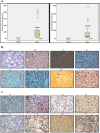Over-expression of telomere binding factors (TRF1 & TRF2) in renal cell carcinoma and their inhibition by using SiRNA induce apoptosis, reduce cell proliferation and migration invitro
- PMID: 25730259
- PMCID: PMC4346586
- DOI: 10.1371/journal.pone.0115651
Over-expression of telomere binding factors (TRF1 & TRF2) in renal cell carcinoma and their inhibition by using SiRNA induce apoptosis, reduce cell proliferation and migration invitro
Abstract
Telomere binding factors viz. TRF1 and TRF2 are a part of sheltrin complex that are present exclusively at the ends of chromosomes. These factors play an important role in maintaining chromosomal integrity at the ends. However, their status and role are not clear in renal cell carcinoma (RCC). Therefore, the present study was conducted to evaluate TRF1 and TRF2 expressions in RCC tissues. Further, the role of these factors involved in tumorigenesis was elucidated by gene silencing using siRNA in RCC cell line (A498). The present study documented a significant over-expression of TRF1 (P = 0.005) and TRF2 (P = 0.0048) mRNAs by real time PCR in RCC tissues as compared with adjacent normal kidney tissues. Immunohistochemistry studies also revealed higher expression of TRF1 and TRF2 proteins in RCC. Moreover, TRF1 or TRF2 gene silencing using siRNA showed marked reduction in proliferation of RCC cells (P = 0.000). Further, significantly induced cell cycle arrest (P = 0.000) and apoptosis of RCC cells (P = 0.000) was documented upon TRF1 or TRF2 gene silencing. Henceforth, the results deduce that TRF1 or TRF2 inhibitions play an important role in the induction of apoptosis in A498 cells, which may serve as a potential therapeutic target in RCC.
Conflict of interest statement
Figures





Similar articles
-
Up-regulation of telomere-binding TRF1, TRF2 related to reactive oxygen species induced by As(2)O(3) in MGC-803 cells.Eur J Pharmacol. 2005 May 23;516(1):1-9. doi: 10.1016/j.ejphar.2005.04.022. Eur J Pharmacol. 2005. PMID: 15904916
-
Curcusone C induces telomeric DNA-damage response in cancer cells through inhibition of telomeric repeat factor 2.Biochim Biophys Acta Proteins Proteom. 2017 Nov;1865(11 Pt A):1372-1382. doi: 10.1016/j.bbapap.2017.08.022. Epub 2017 Sep 21. Biochim Biophys Acta Proteins Proteom. 2017. PMID: 28870734
-
Coordinate regulation between expression levels of telomere-binding proteins and telomere length in breast carcinomas.Cancer Med. 2012 Oct;1(2):165-75. doi: 10.1002/cam4.14. Epub 2012 Jul 24. Cancer Med. 2012. PMID: 23342266 Free PMC article.
-
Post-translational modifications of TRF1 and TRF2 and their roles in telomere maintenance.Mech Ageing Dev. 2012 Jun;133(6):421-34. doi: 10.1016/j.mad.2012.05.002. Epub 2012 May 23. Mech Ageing Dev. 2012. PMID: 22634377 Review.
-
TRF1 and TRF2: pioneering targets in telomere-based cancer therapy.J Cancer Res Clin Oncol. 2024 Jul 16;150(7):353. doi: 10.1007/s00432-024-05867-3. J Cancer Res Clin Oncol. 2024. PMID: 39012375 Free PMC article. Review.
Cited by
-
Hispidulin Enhances Temozolomide (TMZ)-Induced Cytotoxicity against Malignant Glioma Cells In Vitro by Inhibiting Autophagy.Comput Intell Neurosci. 2022 Jun 28;2022:5266770. doi: 10.1155/2022/5266770. eCollection 2022. Comput Intell Neurosci. 2022. PMID: 35800695 Free PMC article.
-
Reduction in H3K4me patterns due to aberrant expression of methyltransferases and demethylases in renal cell carcinoma: prognostic and therapeutic implications.Sci Rep. 2019 Jun 3;9(1):8189. doi: 10.1038/s41598-019-44733-y. Sci Rep. 2019. PMID: 31160694 Free PMC article.
-
p38 MAPK pathway and its interaction with TRF2 in cisplatin induced chemotherapeutic response in head and neck cancer.Oncogenesis. 2018 Jul 9;7(7):53. doi: 10.1038/s41389-018-0062-6. Oncogenesis. 2018. PMID: 29983416 Free PMC article.
-
Telomere Maintenance and DNA Repair: A Bidirectional Relationship in Cancer Biology and Therapy.Cancers (Basel). 2025 Jul 9;17(14):2284. doi: 10.3390/cancers17142284. Cancers (Basel). 2025. PMID: 40723168 Free PMC article. Review.
-
Expression and functional analyses of TERF2 in esophageal carcinoma.Heliyon. 2024 Sep 18;10(18):e38040. doi: 10.1016/j.heliyon.2024.e38040. eCollection 2024 Sep 30. Heliyon. 2024. PMID: 39328506 Free PMC article.
References
Publication types
MeSH terms
Substances
LinkOut - more resources
Full Text Sources
Other Literature Sources
Medical
Research Materials
Miscellaneous

